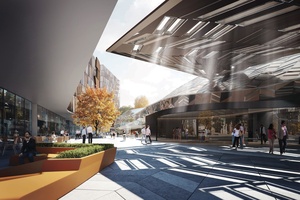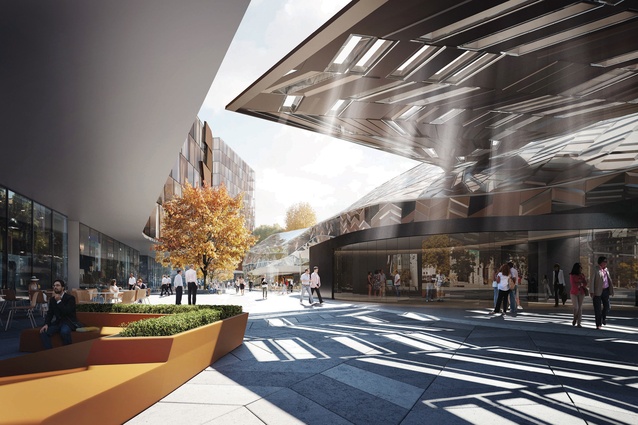Opinion: Barnaby Bennett
Does the media affect the way our cities are constructed? If so, what does the current upheaval in the media landscape mean for the built environment and architecture in New Zealand?

At first this idea might seem unusual or far-fetched, for what do journalists and media organisations have to do with the work of urban designers, planners and architects? If, however, we accept that many of the big spatial decisions that determine the nature of our cities are made in the public sphere, and that the public sphere is, to a large degree, determined by the way that the media portrays controversy, then it becomes an important question.
Debates about developments and public space take place across many different points of social interaction via changing technologies: town hall meetings, political debates, letters to editors, online lobbying, social media and personal contacts. Big decisions are never informed solely by experts but are influenced by a complex weave of contested facts, popular momentum, injustices, narratives and expert knowledge.
These things rise or fall in the public domain through the media. Important historical examples include Bastion Point, Manapōuri Dam and the Auckland waterfront stadium, and current debates are those such as the Basin Reserve in Wellington, Hundertwasser Museum in Whangarei and the Ports of Auckland expansion.
I’ve introduced a big topic, one worthy of a book. In this article, I am going to touch on the subject by comparing the two big convention centres being planned in Auckland and Christchurch.
Currently, New Zealand is building five convention centres – in Auckland, Hamilton, Wellington, Christchurch and Queenstown. They are being delivered through an impressively broad range of mechanisms: local council debt, taxpayer ‘gifts’, specific legislative trade-offs and emergency post-’quake powers. What they all share is a commitment to the idea that using public money to attract people for conventions and meetings is a worthy investment.
It is a simple logic that aims to build jobs and business activity around the high-paying visitors that come to conferences. It is a logic that is complicated by the fact that the centres themselves always lose money and so require some kind of subsidy, from somewhere, to create the broader benefits.
In Christchurch and Auckland, the physical spaces for meeting are wrapped up amongst other money-making services, like hotels and restaurants, to incentivise the deal for the owners.
In terms of economic development, the problem is that the only companies big enough to handle these large and high-quality investments are foreign, so the profits flow overseas and the jobs that are created are largely on the low-wage and casual end. Tim Hunter, chief executive of Christchurch and Canterbury Tourism, has attempted to make this into a positive, stating that, “the good news is that many of these jobs will be available to students and younger employees on a part-time basis”.
In an excellent analysis of the centres in five different cities, commentator Gordon Campbell asks whether “the building of convention centres becomes our new cargo cult” and concludes that they amount to “a very expensive job-creation scheme”.
The Auckland convention centre has been well explored in the media. SKYCITY will build and run an international-scale convention centre in exchange for land adjacent to the site, previously owned by TVNZ, and concession on the number of pokie machines that the casino can operate. It will cost around $600 million to build and cater for up to 3,100 guests. The Auckland centre is being designed by Warren and Mahoney.
It’s a great story featuring all sorts of turns and twists, including allegations of corruption and attacks on the poor. It has been covered extensively by the media and political commentators from across the spectrum.
On 7 August 2014, the Government announced that the consortium Plenary Conventions New Zealand had won the contract to construct the large Christchurch centre. This group includes significant Christchurch property owners The Carter Group and Ngāi Tahu Property. A large French company AccorHotels will run the hotels and convention centre when built. Woods Bagot is leading the centre’s design with support from Warren and Mahoney.
There are now conflicting reports on the cost: Minister Brownlee says that the Government will commit $284 million, while the Prime Minister John Key has indicated this will increase, at one point suggesting that, as costs had escalated to $420 million, the scale would be reconsidered.

The shifts and announcements regarding the Christchurch Convention Centre have been reported dutifully in the national press but coverage has served as almost nothing beyond the broadcasting of government announcements – with none of the commentary, critique and political pressure of the SKYCITY project.
So what could explain the difference in coverage between these two responses and why the Auckland case was subject to more scrutiny?
Unusual legislation was passed to enable the Auckland version. Yet, this doesn’t make it exceptional. The only reason the Christchurch Convention Centre is possible is because of the incredible CERA legislation that enabled Minister Brownlee to pass an entire city plan into law without any consultation.
Another would be that the Auckland centre constitutes a more-aggressive attack on the poor and/or those addicted to pokies. This is a particularly odd aspect of the Auckland centre. However, there is also nearly $300 million of public money being ‘gifted’ to Christchurch for its project that is going largely to support multi-national corporates. This money could be going to other more direct areas of social concern or urban improvement in a city struggling with housing and homeless crises.
Lastly, the fact that the Auckland centre is designed to be the primary international centre gives it more importance. Yet, the Christchurch centre occupies a much bigger and more crucial area in its city; it is being built on probably the two most important blocks on the north edge of Cathedral Square and east of the Avon. I’ll remind the reader that the public has not had a single opportunity to engage with the placement, scale or nature of this project, and there is no intention from the Government to enable this.
My hypothesis is there are two main, intertwined factors that have created the relative difference between these stories: non-regional media and lack of narrative.
The location of most of the media, and almost all of the TV media, is now in Auckland and this inherently favours focused attention on Auckland affairs. In the book Once in a Lifetime: City-building after Disaster in Christchurch (disclaimer: I co-edited this book), documentary-maker Gerard Smyth writes a short and impactful essay that argues that the centralisation of TV media in Auckland has created two significant issues. Firstly, Aucklanders don’t get to see Christchurch stories as told by Christchurch people and so, by extension, the political success of affairs in Christchurch is judged mostly by what the large voting population in Auckland perceives via this media.
Secondly, and far more critically, Christchurch people are inhibited from having conversations with themselves. It is obvious how this might impact on a population’s ability to develop the nuanced and sophisticated conversations necessary when a community is recovering from a major disaster. Local printed media has provided robust coverage but a single paper cannot maintain the kind of pressure and rapid updates that are characteristic of a fast-moving story.
Another factor is that the Government’s secrecy over the details of the Christchurch Convention Centre, and lack of engagement with the public, has allowed them to proceed with less discussion and less critical examination. It is easy to see how this can be read as a direct consequence of the first factor.
Smyth writes: “In some ways, the lack of strong and functional mainstream television media in Christchurch must be a godsend to those who are making decisions. Their subjects are placid and have long learned to acquiesce to being voiceless. But is this really how a vital community best functions?”
To put the difference into focus: in an interview with Chris Lynch on 9 June this year, nearly three years after the announcement of the convention project, the Prime Minister stated that he suspects that if they did an analysis of the need for a convention centre, the Government would probably support the project.
That the Government is making a $284-million investment into Christchurch without any public business case has gone unreported by the nation’s media. I find it impossible to imagine that this would not have caused significant concern if a similar statement had been made about the SKYCITY deal.
This isn’t a story of Auckland against the rest of the country, nor one of political manipulation. It is an attempt to understand how big important moves in our cities are made – over a billion dollars’ worth in these two projects – and how the media helps and hinders the public’s role.











